|

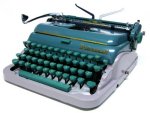

 

















 







  
Other pages on this site:

Collapsing World: a blog

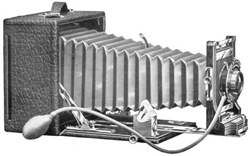
Conley Cameras

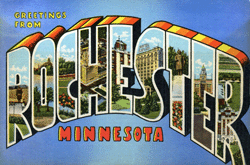
a history in postcards
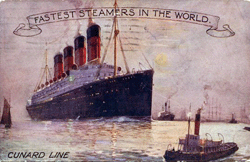
Vintage ocean liner postcards

My non-typewriter photography
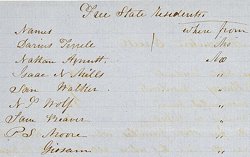
Genealogy, with a focus on the Seaver, Bilyeu, Amidon, and Lowell branches
This site is copyrighted. Please don't use any of the materials here without my permission.
|



|

Bing
#2
1927
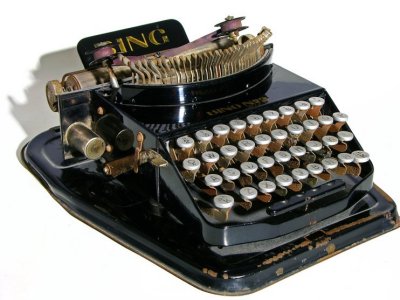
See my Depression-Era Portables page for more information about the history of this uncommon German machine. |

Blickensderfer No.9
Serial # 191458
c.1919
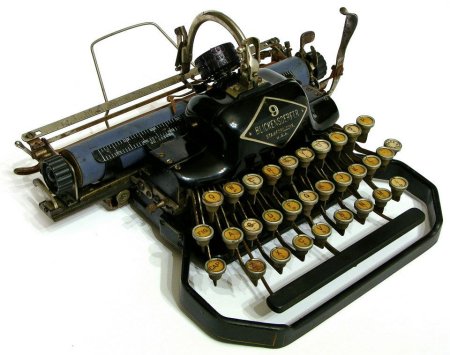
The "five-pound secretary" has its last hurrah in this pleasing little art deco number. No.9 did away with the freakishly large tabulator system introduced in the No.7, and the armature which holds the inking pad was changed from a horizontal horseshoe shape to a graceful arc which could be turned down and out of the way for storage.
In 1919, the traditional Blickensderfer was replaced with a conventional typebar portable called the Blick Ninety, which bore more than a little resemblance to the Corona 3. The new model was a flop, and the company went out of business not long after.
According to the book, The Five-Pound Secretary, the highest known Blick 9 serial number is 198,111, so this one is indeed very near the end of the run.
|

Brother DeLuxe
Serial # B6138861
1966
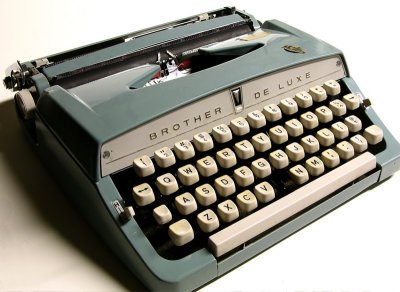
|

Brother Opus 889
Serial # B1204710
1971
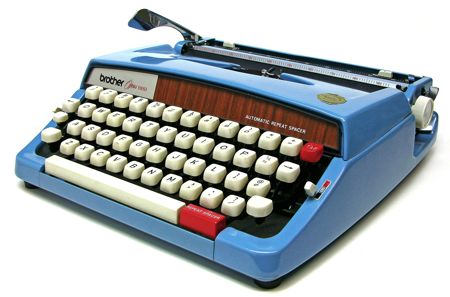
The Opus 889 appears to be the exact same machine as the Webster XL-747.
I was surprised at how much I really like this machine. It's action is smooth and easy, and it feels precise and solid. It's appearance may not appeal to those who prefer a more vintage typewriter aesthetic, but for anyone looking for a good, compact typewriter, I heartily recommend this one.
|

Caligraph #2
Serial # 11456
c.1886
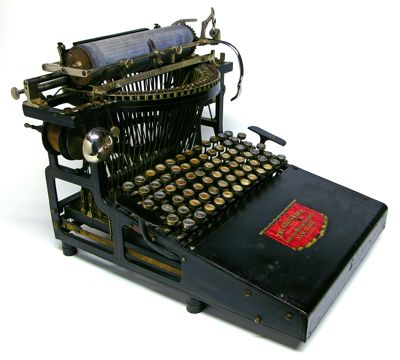
A freebie that someone threw in when I bought another machine. To date, I have the distinction of not having paid a single cent for any of my Caligraphs!
Did you know that many Caligraphs harbor a secret underneath the front cover? Click here to find out! |

Caligraph
#4
Serial # 11322
c.1897
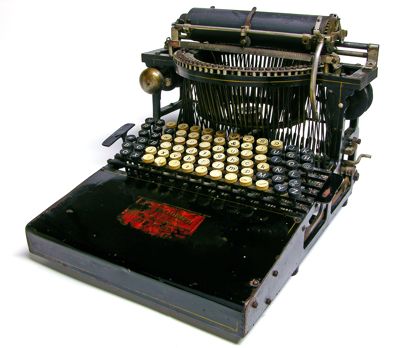
The No. 4 was First produced in 1894, but this one is probably
much newer. Dating Caligraphs is largely guesswork, since no official production data exists. This was my first truly collectible typewriter. I found it sitting on the hood of a neighbor's car in the alley behind our house
during a snowstorm, along with the Remington Noiseless #6. The neighbor
was going to throw them both out and I asked them to give them to me instead. Both had cloth covers
which unfortunately were rotted and unsalvagable and had to go in the
trash. But, hey, free Caligraph!
This particular Caligraph is also equipped with an unusual attachment: a Standard Type-Cleaner crank brush. Click here to see it and read more about how it works. |

Commodore Educator
Serial # 031130287
c.1958-1963
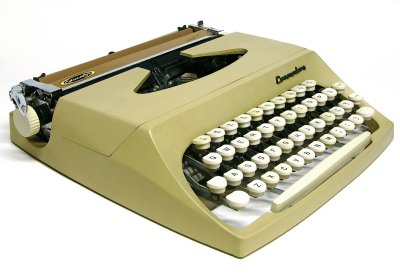
Before Commodore became
famous for calculators and computers, they sold typewriters. Which isn't to say that they made typewriters; most were other manufacturers' typewriters rebadged with the Commodore name. This one is likely a Consul 232, made under license in Canada.
Download the manual for this typewriter here. |

Continental
Serial # 501962
1947
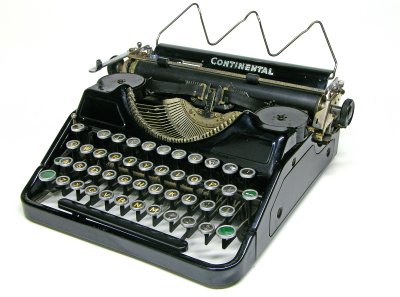
Wanderer-Werke was a German company well-known for its innovative and high-quality office typewriters. This post-War portable was made in Belgium, where Wanderer-Werke moved its operations to in the height of WWII, and is considered to be of far lower quality than its German-made predecessors. |

DeJur-Triumph Perfekt
See: Triumph-DeJur Perfekt |

Everest
K3
Serial # 1101320
1962
Emeritus collection.

It's been pointed out on the Yahoo
Portable Typewriter Forum that this model isn't supposed to exist.
One of four known specimens. Serial number records hint that this
machine was only produced from 1960-1962, with the last serial number
being 1112000, so this one is truly from the end of the line. It's likely
a last-gasp effort by Erika to penetrate the "ultralight" portables
market. Either that or they bought out a foundering typewriter company
and sold the leftover machines under the Everest brand until the remaining
parts petered out. It's suspected that the K3 might be a Tippa variant.
More information as it becomes available. |

Facit TP2
1964-1968
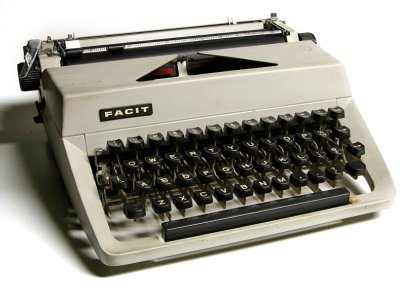
|

Fox No.5
Serial # 5565
c.1903
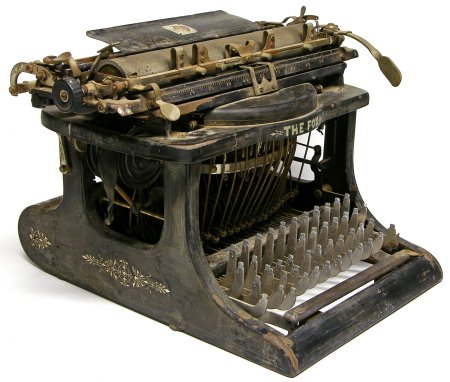
I rescued this one from a keychopper who had already pulled off the keys. Fortunately, the keys are easily pushed back onto their levers and I persuaded him to give me the whole machine for the price of the keys. The photo above is how it looked as I got it. Conservation efforts are underway.
The No.5 is a variation of the No.4, the primary difference being the length of the platen. The No.5 can accept paper 12" wide and type a line 9.5" long, whereas the No.4 accepts 9" wide paper and types a line 7.5" long. No.s 6, 7, & 8 are further variations of gradually increasing platen length.
Serial numbers are very tricky to find on Fox upstrikes. They are usually stamped in two places: on the underside of the lever which lifts the platen, and on the right end of the nickeled band surrounding the type bars. I've also heard of it being stamped on the upper frame near the type basket opening.
Though some ads announcing the Fox visible indicated that upstrikes would continue to be manufactured in parallel, there is no evidence that the line continued beyond the Fox No.23's debut in 1906.
|

Fox
No.23
SN 02792 / 18792
c. 1906-1908
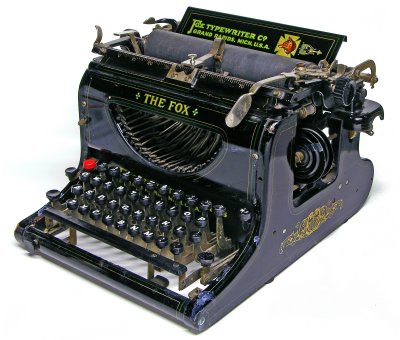
Note the presence of a tab plunger in the front frame, but no backspace on the right above the keyboard. The model was introduced in 1906 and the tabulator added in mid-1909. Very early models have no tab plunger.
The serial number can be difficult to find. It can be seen by shining a light through the type basket opening; the number(s) will be stamped on a bar immediately underneath the carriage. Older Fox visibles have two sets of numbers, with the last three digits of the larger number always equaling the last three of the smaller number. Although no one knows for sure the significance of the two numbers, there is a theory afoot that 16,000 serial numbers were allocated for the blind series of models and the larger # is the total production of visible typewriters added to the upstrike total. (If the theory of 16,000 pre-allocated serials is true, this may be evidence that Fox initially planned to continue upstrike production in parallel with the visible.) Later Foxes have only one, significantly larger number. This may have been a bit of a parlor trick to make the visible's production numbers appear higher.
Richard
Polt has written up an excellent history of this attractive machine, as has Will Davis. |

Fox No.24
Serial # 122725
c.1921
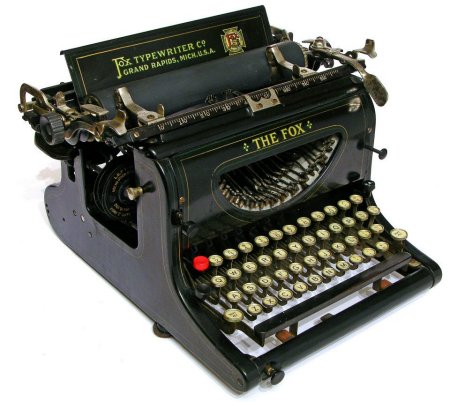
The first thing that one notices about this late-model No.24 is that it has traditional black-on-white ringed keys. Also, the paper tray logo has changed. Less noticeable is the fact that the aluminum key levers have been eliminated and replaced with thinner, stamped-steel levers. The serial number has also been moved to a more easily located plate behind the carriage.
|
|

Harry
A. Smith #6
Serial # 17019
c.1914
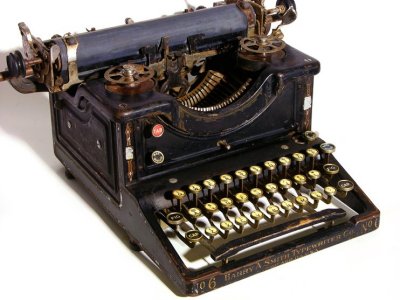
Harry Annell Smith specialized
in buying up the inventories of failing typewriter companies and rebranding
the machines as his own. Amongst others, he resold Victors, Emersons,
Annells, and Blick-Bars. This machine is a rebranded Harris Visible
#4. To date, this is the only known surviving Smith-branded Harris. (Curiously, collector Richard Polt has found an altogether different Harry A. Smith #6. His is a rebadged Victor, not a Harris!) The leading theory right now is that this one was one of 800 Harris Visible
#4 machines bought by Sears for internal use or resale through its catalog, and the
unsold inventory was purchased by Smith when the Harris company went
under. This would explain the relatively low serial number. Click here, here,
and here for more photos.
Also see Will Davis's Harry A. Smith and Harris Visible pages for more information. |
|
|

Imperial Good Companion
Serial # AQ381
1936
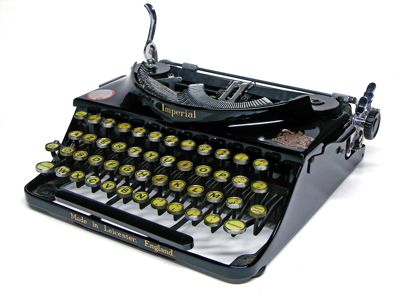
French keyboard. The Good Companion--named after Imperial user J.B. Priestly's play of the same name--was an extremely popular British-made typewriter. Introduced in 1932, the machine likely had its origins in the Regent, a very similar earlier collaboration between Imperial and Germany's Torpedo Buromaschinenwerke. It uses a geared-lever mechanism much like Remington portables of the time, but the two are otherwise dissimilar. |
|

Keaton Music Typewriter
Serial # 3180
c.1955
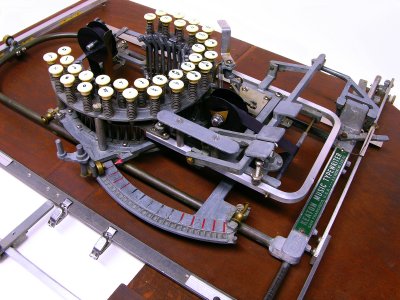
Special page about this most unusual writing machine and its inventor coming soon! Until then, please see my blog post about the Keaton for more information. |

Optima P1
Serial # 260641
1959
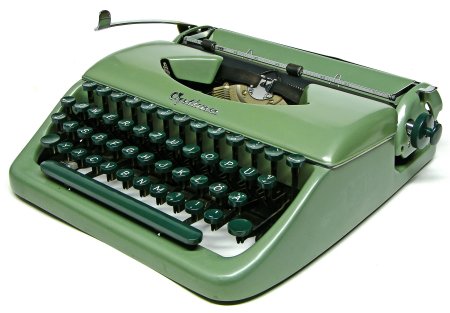
When Germany was split into East and West, the Olympia factory in Erfurt ended up on the East side, under Soviet control. That factory became Optima Buromaschinenwerke. (The whole Olympia East-West split was much more complicated from a corporate perspective, but in a nutshell that's what happened.) The Optima P1 is based on the Olympia Plana. Optima also made a larger portable called the Elite, and a standard.
Although as a Soviet product Optimas were banned from import into the U.S., the Elite is not all that uncommon. I know that at least one East Coast typewriter dealer used to drive into Canada and load his trunk with East German typewriters and smuggle them back into the United States. The P1 is fairly scarce, though.
Download the manual for this typewriter here.
|

Reliance Visible
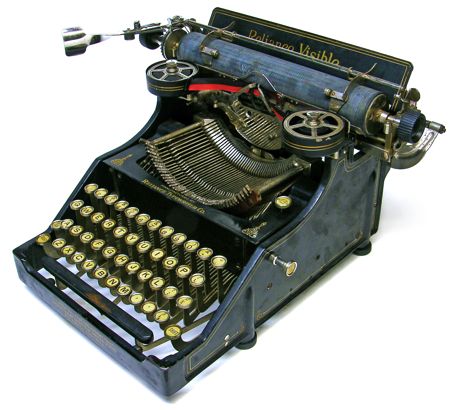
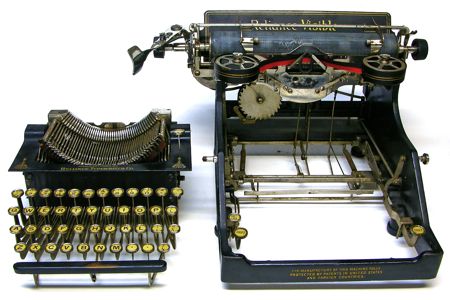
The Reliance Visible was a revival of the Pittsburg Visible No.12 after that company had gone out of business. There's considerable evidence that the Reliance Typewriter Co was wholly owned by Montgomery Ward; therefore, it may belong in the Catalog Typers section.
The Reliance Visible had the unusual feature of being able to remove the entire keyboard and typebasket at once. A unit with a different typeface could then be dropped in its place.
|

Seidel & Naumann Erika #3
Serial # 58223
c.1922
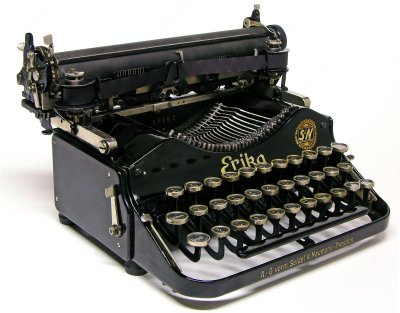
The folding #3 Erika was made in Dresden, Germany from 1910 to 1923. There's some speculation that the design infringed on the Standard Folding's patent and led to the folding Erika's eventual demise. |

Seidel
& Naumann Erika #5
Serial # 722290/5
c.1937
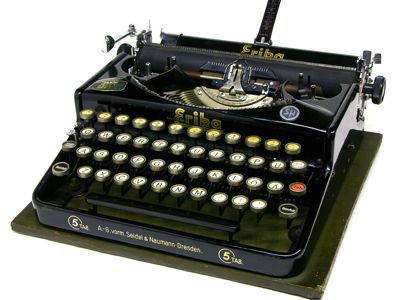
This German typewriter was brought to the U.S.
by an American GI returning from WWII. It lives in a hinged, olive-green
wooden box built by the soldier. Sadly, his name, and the assuredly remarkable
history of this machine, is lost. |

Stenotype
Master Model Four
Serial # A3687
C. 1930
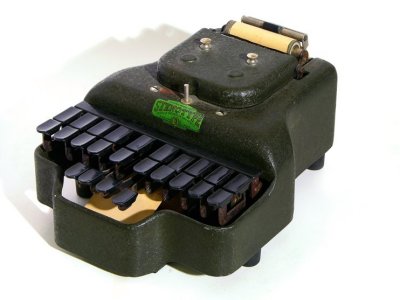
|

Tom Thumb model 1641
Serial # 1421051072
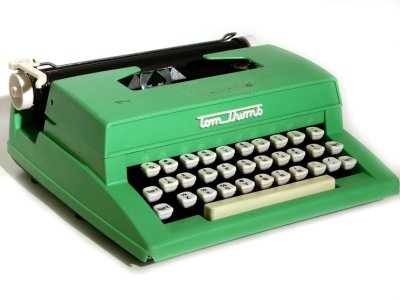
Sure, it's made of plastic, and sure, it's made by Western Toy and Stamping Co, but I have a hard time thinking of the Tom Thumb as a "toy". It sports as many features or more than some "real" typewriters (see the Royal Signet or Corona Jr), and is no less flimsy than many plastic Japanese typewriters from the '70s. To each his own. |

Torpedo 17
See: Remingtons |
|
|

Triumph Norm 6
Serial # 447256
1944
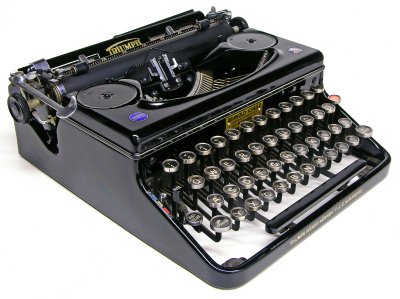
Triumph-Werke Nürnberg introduced its line of portables in 1928 with three models: the Durabel, Norm, and Perfekt. The Norm lacked the Perfekt's tabulator, while the entry-level Durabel further lacked a ribbon color selector, paper guide, and additional paper guides behind the platen.
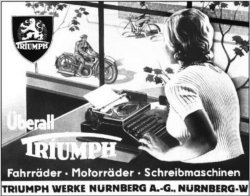 1939 ad touting Triumph's trifecta of products
1939 ad touting Triumph's trifecta of products
Triumph is probably better known for its motorcycles. During WWII, the company produced tens of thousands of motorcyles for the German army at the same factory in Nuremberg where it also built bicycles and typewriters. After May, 1941, it became nearly impossible in Germany to purchase a typewriter without a special ration coupon. As the government became increasingly paranoid about subversives and seditionists, it tightly restricted who could own a typewriter. In July, 1942, all German Jews were ordered to turn in their typewriters, along with other items such as furs and bicycles. By the end of 1942, Triumph ceased production of typewriters for the civilian market altogether. Triumph continued to make typewriters in limited numbers for goverment offices.
In 1943, allied bombs destroyed the factory's pipe warehouse and the company archives in the administrative building. In April, 1945, as the fall of Germany at the hands of Allied forces drew near, all businesses were ordered closed. A "scorched earth" strategy began to prevent anything of use from falling into the hands of Americans. Roads and bridges were blown up. Factories were ordered to destroy their equipment. At Triumph, a small group of employees led by Paul Reil were tasked with the destruction of all tools and manufacturing equipment. Instead, they carried out a bold covert operation to save their factory. Important machinery parts were boxed, labeled, and hidden. Nazi officials were instead given boxes of old parts, which were taken away in trucks. Then they stayed to protect the factory from being ransacked. For days, the group huddled in the otherwise abandoned factory as shells from both German and Allied guns rained upon the buildings, making periodic forays beyond the factory walls to forage for food for themselves as well as the numerous forced-labor prisoners who lived on-site. On April 20, American troops arrived. The group's stash of guns was confiscated, and the employees generally placed under house arrest within the factory (the forced laborers were set free, though). However, seeing the value of a semi-operational factory that could fabricate parts, the Americans were more or less good to the workers and had them restart areas of the factory to help keep American military equipment supplied.
In May, 1945, about 220 workers relaunched production, making wheelbarrows and trolleys at first, then gradually resuming production of bicycles and typewriters.
|

Triumph-DeJur Perfekt
(aka DeJur-Triumph)
SN 1231021
1957-1960
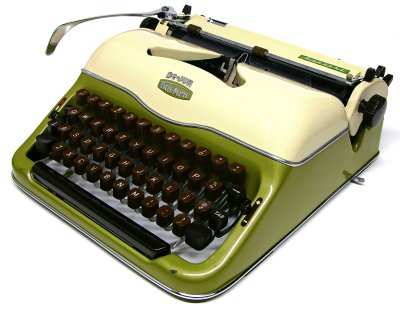
The Dejur-Triumph Perfekt was the same Perfekt typewriter that had been sold in Europe since 1952. In 1957, shortly after Grundig's buyout of Triumph, The Dejur-Amsco Corp of Long Island began to import Triumph typewriters as well as other Triumph office products under the DeJur-Triumph moniker.
DeJur-Amsco Corp was founded by Ralph A. DeJur and his brother Harry in the late 1920s. Before they were importers of office products, the DeJur name was well-known on cameras. From the late '40s throughout the '50s, DeJur-Amsco redistributed all manner of photographic equipment, mostly from Neidig Kamerawerk of Plankstadt, Germany. In addition to Triumph products, DeJur added their name to many pieces of Grundig-brand audio equipment, such as dictaphones, radios, and tape recorders.
It's unknown how many Dejur-Triumph typewriters entered the US. Only a handful of DeJur Perfekts have surfaced, all with serial numbers in the low 122xxxx to mid 123xxxx. This suggests only a few thousand units of sequential numbers, probably purchased by DeJur in one lump shipment.
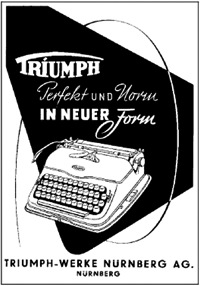 1952 ad announcing Triumph's
1952 ad announcing Triumph's
redesigned portables
Noteably, the manufacturing label of the back of the typewriter is pure Triumph. There is no suggestion of Adler's involvement (Grundig merged the two companies the same year it assumed Triumph ownership, 1957). One would expect machines manufactured from mid-1957 on to bear the new Triumph-Adler name. My personal guess is that Grundig struck the deal with DeJur as a way of emptying warehouses of already-manufactured equipment, excess stock that would have been an asset liability when the time came to merge Triumph and Adler. So the DeJur-Triumph models found here in the states may all have been manufactured prior to late 1957.
A whole new design of Triumph-Adler Perfekts emerged in 1961. The Typewriter Serial Number Database indicates that these started at serial number 1282000. |

Viking
Serial # 54302
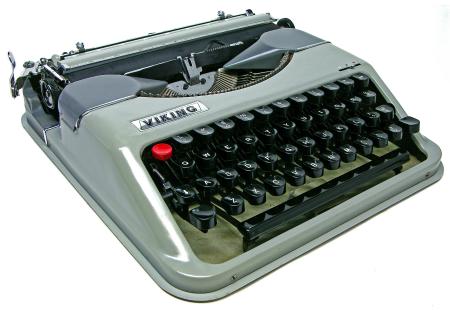
If this Viking looks familiar, that's because it's a clone of the Hermes Baby. It's actually a name variant of the Montana, a Torino (Turin), Italy, company that manufactured licensed clones of the Baby starting in 1950. This particular unit was imported by Typewriter Distributors, Inc. of New York, and probably also dates from the early 1950s. I'm told its original owner was a performer with the Ringling Bros and Barnum & Bailey Circus, so this typer probably could tell many interesting stories! |

Voss DeLuxe (model S-24)
Serial # 164869
1959
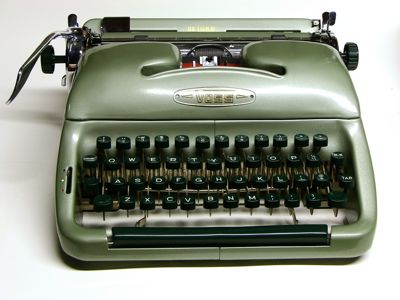
Voss was a moderately successful, high-quality brand made in West Germany beginning in 1948. This particular machine was made during the second-to-last year of its model's production. After 1960, the company focused on more economical portables, but did not achieve success in this arena and folded within five years. |

Wellington No.2
Serial # 5063
c.1898
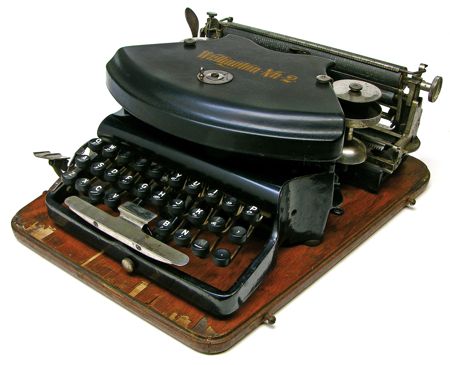
Identical to the Empire, the Wellington is a thrust-action machine by Wellington Parker Kidder, of Franklin and Noiseless fame. Made under license in Germany, a slightly modified version was sold as the Adler 7 and launched Adler's long success story. Later, Kidder would improve and redesign his thrust mechanism with the Noiseless. Under Remington ownership, the Noiseless continued to be produced into the 1950s. In terms of longevity, the Empire/Wellington can be considered one of the most influential typewriters in history. (In fact, I once proposed a game called "Six Degrees of Wellington Kidder".)
|

Woodstock #4
Serial # A21469
1916
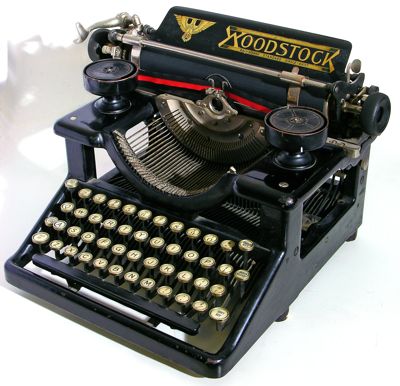
Lots of Woodstocks around, but this one appeals
to me best with its less-common art-deco bird logo. It types like the wind, too. |

Yost No.4
Serial # 42596
1915
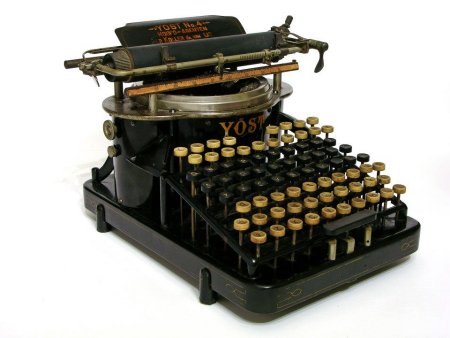
|
|
![]()
![]()